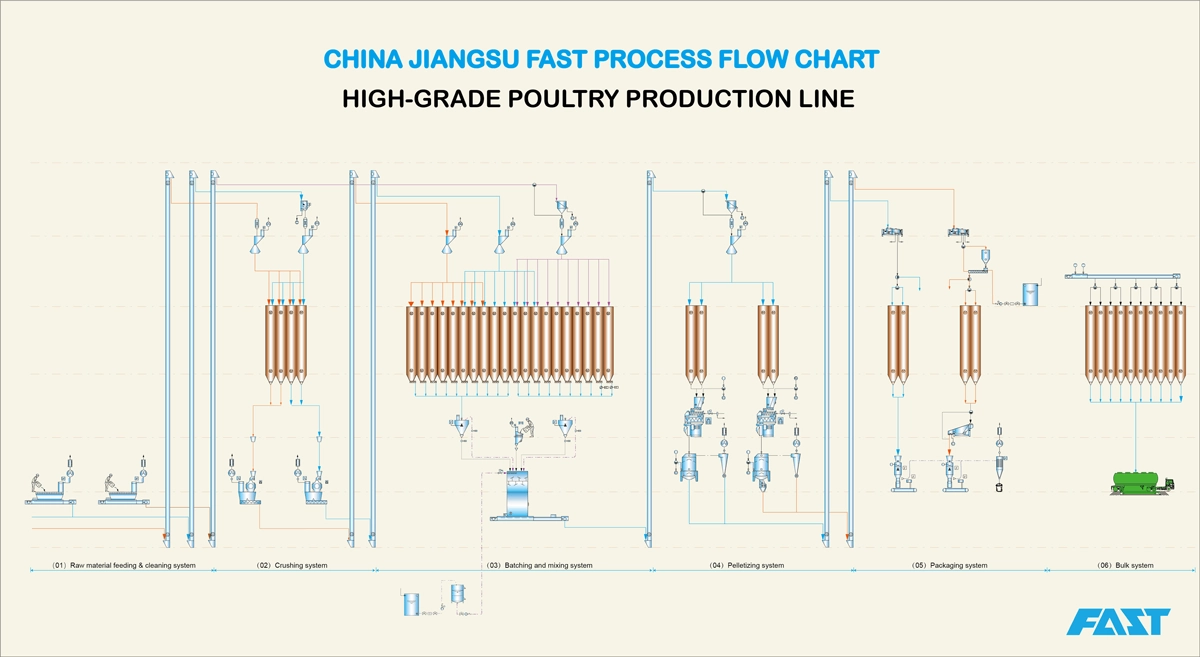Poultry feed production line is an equipment system used to produce poultry feed. Its configuration plays a vital role in the quality and efficiency of feed production. When configuring a poultry feed production line, the following requirements need to be considered.
First, the equipment configuration of the poultry feed production line needs to meet the requirements of the production scale. Determine the scale of the production line according to the scale and demand of poultry farming. Generally speaking, the equipment of the poultry feed production line includes raw material cleaning, crushing, mixing, granulation, cooling, screening, packaging and other links. According to the scale of the production line, the number and specifications of equipment in each link need to be determined to meet production needs.
Raw material receiving and storage equipment: Large storage silos are required for temporary storage of raw materials such as corn and soybeans. These warehouses should be equipped with horizontal and vertical stirring devices to ensure the uniformity of the quality of the raw materials. At the same time, there should be an automatic metering and conveying system to accurately transport the raw materials to the next processing link.
Cleaning equipment: Raw materials often contain various impurities, such as mud, stone, metal fragments and harmful organisms, etc., and efficient cleaning equipment such as stone removers, magnetic separators, screening equipment and dust removal systems are required to remove these impurities that may affect feed quality and animal health.
Crushing equipment: The crusher is an indispensable equipment. It is responsible for crushing the cleaned raw materials to increase their specific surface area, which is conducive to subsequent mixing and granulation. Different raw materials have different processing requirements. For example, grains need to be cleaned, crushed, ground, etc., while bone meal needs to be crushed, defatted, etc. Therefore, when configuring equipment, it is necessary to consider the processing flow and equipment requirements of different raw materials. It is necessary to select a suitable crusher according to production needs to ensure the processing effect of the raw materials and the quality of the feed.
Mixing equipment: The mixer needs to be able to mix different raw materials and additives evenly to ensure the uniformity of the nutritional content of the feed. This requires the mixer to have high mixing efficiency and short cycle time, and easy to clean to prevent cross contamination.

Granulating equipment: The granulator is the core part of the production line. It compresses the mixed materials into shape. Common ones are ring die granulators and flat die granulators. The selection of granulators should consider their output, energy consumption, mold life, and adaptability to different formula materials.
Cooling equipment: After granulation, the temperature and moisture content of the feed are high, and it needs to be cooled and dried by a cooler to prevent the feed from moldy and deteriorating. The cooler should have sufficient cooling area and good ventilation.
Screening and crushing equipment: The cooled feed needs to be screened to separate particles of qualified size and oversized or unqualified particles. For unqualified particles, they can be sent to the crusher for re-crushing or returned to the pelletizing process.
Finished product storage and packaging equipment: Finished feed needs to be properly stored, and an automated packaging system is used for weighing, sealing, stacking and other operations to improve packaging efficiency and reduce labor intensity.
Control system: The entire production line should be equipped with an integrated control system to achieve automatic control and monitoring of the entire process of raw material distribution, processing, and finished product packaging. Modern control systems can provide functions such as data recording, fault diagnosis, and remote control, which can significantly improve production efficiency and management level.
Safety and environmental protection equipment: The design of the production line also needs to consider operational safety and environmental protection, including the setting of emergency stop buttons, dust and explosion prevention systems, exhaust gas treatment devices, and wastewater treatment systems.
When designing and configuring poultry feed production lines, in addition to the above equipment requirements, it is also necessary to comprehensively consider factors such as raw material characteristics, product demand, factory layout, energy consumption, environmental protection, etc. to ensure the scientificity, rationality and economy of the production line. At the same time, with the advancement of science and technology, production equipment is constantly updated, and the configuration of the production line also needs to adapt to the development of new technologies, and continuously improve the level of automation and intelligence to enhance overall competitiveness.